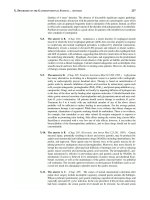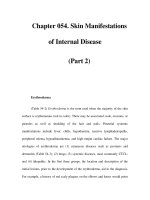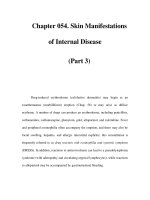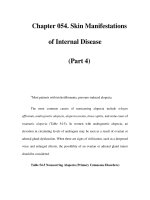Chapter 054. Skin Manifestations of Internal Disease (Part 8) ppt
Bạn đang xem bản rút gọn của tài liệu. Xem và tải ngay bản đầy đủ của tài liệu tại đây (17.37 KB, 7 trang )
Chapter 054. Skin Manifestations
of Internal Disease
(Part 8)
a
Becoming less common.
Poikiloderma is a term used to describe a patch of skin with (1) reticulated
hypo- and hyperpigmentation, (2) wrinkling secondary to epidermal atrophy, and
(3) telangiectasias. Poikiloderma does not imply a single disease entity—although
becoming less common, it is seen in skin damaged by ionizing radiation as well as
in patients with autoimmune connective tissue diseases, primarily dermatomyositis
(DM), and rare genodermatoses (e.g., Kindler syndrome).
In scleroderma, the dilated blood vessels have a unique configuration and
are known as mat telangiectasias. The lesions are broad macules that usually
measure 2–7 mm in diameter but occasionally are larger. Mats have a polygonal or
oval shape, and their erythematous color may be uniform or the result of delicate
telangiectasias. The most common locations for mat telangiectasias are the face,
oral mucosa, and hands—peripheral sites that are prone to intermittent ischemia.
The CREST (calcinosis cutis, Raynaud's phenomenon, esophageal dysmotility,
sclerodactyly, and telangiectasia) variant of scleroderma (Chap. 316) is associated
with a chronic course and anticentromere antibodies. Mat telangiectasias are an
important clue to the diagnosis of the CREST syndrome as well as systemic
scleroderma, for they may be the only cutaneous finding.
Periungual telangiectasias are pathognomonic signs of the three major
autoimmune connective tissue diseases—lupus erythematosus, scleroderma, and
DM. They are easily visualized by the naked eye and occur in at least two-thirds of
these patients. In both DM and lupus there is associated nailfold erythema, and in
DM the erythema is often accompanied by "ragged" cuticles and fingertip
tenderness. Under 10x magnification, the blood vessels in the nailfolds of lupus
patients are tortuous and resemble "glomeruli," whereas in scleroderma and DM
there is a loss of capillary loops and those that remain are markedly dilated.
In hereditary hemorrhagic telangiectasia (Osler-Rendu-Weber disease), the
lesions usually appear during adulthood and are most commonly seen on the
mucous membranes, face, and distal extremities, including under the nails. They
represent arteriovenous (AV) malformations of the dermal microvasculature, are
dark red in color, and are usually slightly elevated. When the skin is stretched over
an individual lesion, an eccentric punctum with radiating legs is seen. Although
the degree of systemic involvement varies in this autosomal dominant disease (due
to mutations in either the endoglin or activin receptor–like kinase gene), the major
symptoms are recurrent epistaxis and gastrointestinal bleeding. The fact that these
mucosal telangiectasias are actually AV communications helps to explain their
tendency to bleed.
Hypopigmentation
(Table 54-9) Disorders of hypopigmentation are often classified as either
diffuse or localized. The classic example of diffuse hypopigmentation is
oculocutaneous albinism (OCA). The most common forms are due to mutations in
the tyrosinase gene (type I) or the P gene (type II); patients with type IA OCA
have a total lack of enzyme activity. At birth, different forms of OCA can appear
similar—white hair, gray-blue eyes, and pink-white skin. However, the patients
with no tyrosinase activity maintain this phenotype, whereas those with decreased
activity will acquire some pigmentation of the eyes, hair, and skin as they age. The
degree of pigment formation is also a function of racial background, and the
pigmentary dilution is readily apparent when patients are compared to their first-
degree relatives. The ocular findings in OCA correlate with the degree of
hypopigmentation and include decreased visual acuity, nystagmus, photophobia,
and a lack of normal binocular vision.
Table 54-9 Causes of Hypopigmentation
I. Primary cutaneous disorders
A. Diffuse
1. Generalized vitiligo
a
B. Localized
1. Idiopathic guttate hypomelanosis
2. Postinflammatory
3. Tinea (pityriasis) versicolor
4. Vitiligo
5. Chemical leukoderma
6. Nevus depigmentosus
7. Piebaldism
II. Systemic diseases
A. Diffuse
1. Oculocutaneous albinism
b
a. Hermansky-Pudlak syndrome
c
b. Chédiak-Higashi syndrome
d
2. Phenylketonuria
3. Homocystinuria
B. Localized
1. Vogt-Koyanagi-Harada
2. Scleroderma
3. Melanoma-associated leukoderma
4. Tuberous sclerosis
5. Hypomelanosis of Ito/mosaicism
6. Incontinentia pigmenti (stage IV)
7. Sarcoidosis
8. Tuberculoid and indeterminate leprosy
9. Cutaneous T cell lymphoma
10. Onchocerciasis









